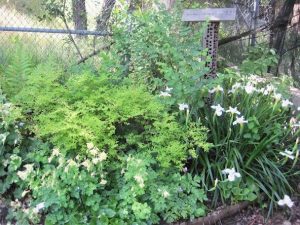There are times when I feel guilty after looking at other gardeners’ excellently-cared-for lawns and gardens, brilliant with flowers or producing copious amounts of food, bristling with highly designed drip irrigation systems or full of native plants. When I expressed to a neighboring homeowner how impressed I was with her garden and fruit orchard, she talked about the amount of time it took and how much work it is. Over time, I have assuaged my guilt by counting the ways in which being a lazy gardener has worked for me.
1. Sometimes nature will do your pruning for you. When I moved into my house, the back-yard contained a declining variegated box elder full of dead limbs. At a gardening seminar, a bot-anist told me, “Once those box elders start to fall apart, you just need to take them down.”
I resisted. It provided the only shade in my backyard. Every few years I would prune out the newest dead branches and hope that I could nurse it along until other trees (baby oaks that I was nurturing) could take over as shade sources. One windy, stormy night this winter, as I was read-ing in bed, I heard a strange “tearing” sound and the ground shook. I jumped out of bed, grabbed my trusty flashlight and ran to the back patio. There, lying on the ground was the huge dead branch that I had contemplated so often. Nature had done the job for me!
A few weeks later, during another very windy night, a huge live limb came down from the same tree. The mandate from nature was clear….the tree had to go. So, a neighbor came over and cut the tree to a stump.
Suckers (non-variegated), from the root stock of the downed variegated box elder, are now over seven feet tall and starting to divide into branches. Maybe my shade will come back after all.
2. Pests become less pesty. Several years ago, a Master Gardener friend pointed out soldier beetles (family Cantharidae) on a rose bush. They eat insect eggs and also act as pollinators. I had done nothing to attract them. This year I noticed large milkweed bugs, Oncopeltus fasciatus, on the plants I’ve added for migrating monarch butterflies. Listed as a “nuisance,” the integrated pest management advice for managing them? “Live with them.” (They feed on milkweed plants and their time in the garden is short.) Exactly my style of gardening! And paper wasps (family Vespidae) are building a nest under the eve of my garage. Even though my son-in-law was ap-palled at “dangerous” wasps in such close proximity to our activities, the wasps are welcome in my garden. Unless their nest is directly threatened, they are non-aggressive. According to the University of California Integrated Pest Management website (http://ipm.ucanr.edu/PMG/PEST-
3. My immediate environment has knit together. Plants seem to be creating their own reality. A miniature grove of volunteer young oaks protects the many birds. The California fuchsia sends up new shoots with no attention from me. The only tomatoes growing in my vegetable garden
this year are volunteers from last year’s fallen fruit. The pumpkins setting fruit in the same veg-gie garden were free leftovers at a fruit stand after Halloween that I broke apart and threw into the mulch. Sprawling grapevines, a gift from another Master Gardener friend, help shade my side yard from the blistering sun.
So, sometimes not tending the garden allows it to flourish. Laziness is not always negative.
Rebecca Miller-Cripps is a University of California Cooperative Extension Master Gardener of Tuolumne County.
UCCE Master Gardeners of Tuolumne and Calaveras Counties can answer home gardening questions. Call 209-533-5912 or to fill out our easy-to-use problem questionnaire here. Check out our website here, You can also find us on Facebook.

